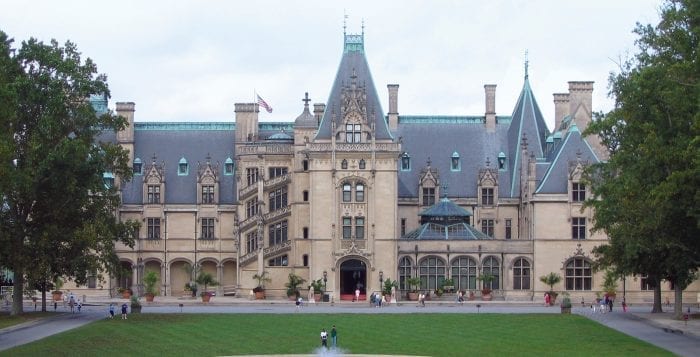Between You and Me: Biltmore Estate and Downton Abbey Celebrate the Gilded Age
By Leah S. Dunaief

Leave the coronavirus, Biden and Sanders behind for now and come with me to a delightful place. I will take you on my magic carpet to the largest private residence in America that is also a historic landmark: the Biltmore.
Located in Asheville, North Carolina, amid the Blue Ridge Mountains, the Biltmore is a country estate built by George Vanderbilt III in the style of a great European manor. To do so took six years of work by an army of artisans, and when the home formally opened Christmas Eve, 1895, it had four acres of floor space, 250 rooms, of which 33 were family and guest bedrooms, with 43 bathrooms, 65 fireplaces, three kitchens and an indoor swimming pool. In addition there were elegant furnishings, tapestries and artwork from Europe and Asia, and the home was ahead of its time with an elevator and
a refrigerator.
The mansion sat on 125,000 acres of forests, farms and a dairy, a 250-acre wooded park, five pleasure gardens and 30 miles of macadamized roadways. The architect was Richard Morris Hunt and the landscaper was Frederick Law Olmsted, known to us as the designer of New York’s Central Park. The cost to build such splendor was nearly $6 million out of Vanderbilt’s inheritance — that is about $1.6 billion today. He was then 33 years old.
Jan Aertsen van der Bilt emigrated to America in 1650 from Holland and was a farmer on Staten Island with his family. But it was Cornelius Vanderbilt ((1794-1877) who made the fabulous fortune. At 16, he borrowed $100 from his mother, or so the story goes, and started a ferry service across New York Bay. That grew into a fleet of more than 100 steamships that went as far as Central America and Europe. Appreciating the value of transportation, he eventually built a second fortune by investing in railroads, including New York Central.
He also believed in philanthropy, donating $1 million to Central University in Nashville that was renamed Vanderbilt University. Continuing with that tradition, his eldest son, William Henry Vanderbilt (1821-85), who in turn doubled the family’s assets, donating generously to the Metropolitan Opera and endowing the College of Physicians and Surgeons, the medical school of Columbia University.
And it was William Henry’s youngest son, George, born in 1862, who built the fabulous Biltmore Estate. He first visited the area in 1888 with his mother, who came to breath the healthy mountain air as a remedy for her asthma. He fell in love with its rugged beauty and decided to build his home, emulating the vast baronies of Europe, in Asheville. It was to be not only a showcase for his large art and book collections but also a retreat for entertaining and a profitable, self-supporting business. And so it is. In addition, with its thousands of original furnishings and artwork, it is an authentic picture of life during the Gilded Age. It is America’s larger version of Downton Abbey, only real.
Visitors can stay at The Inn on Biltmore Estate or other hotels on the property, and take the picturesque shuttles around the estate. There is much to see and do beyond viewing the four-story ornamental French Renaissance château-style mansion. A winery, stables offering carriage and trail rides, farms with animals, gardens, a conservatory and several restaurants and gift shops populate the acres. And flawless customer service from a large staff of some 2,300 accompanies the luxurious setting. More than 1.4 million guests visit the now downsized to 8,000 acres National Historic Landmark house, gardens, winery and village each year. And until April 7, there is an impressive exhibit of Downton Abbey, the series and movie, that further entertains. But at Biltmore, art merely imitates life.







